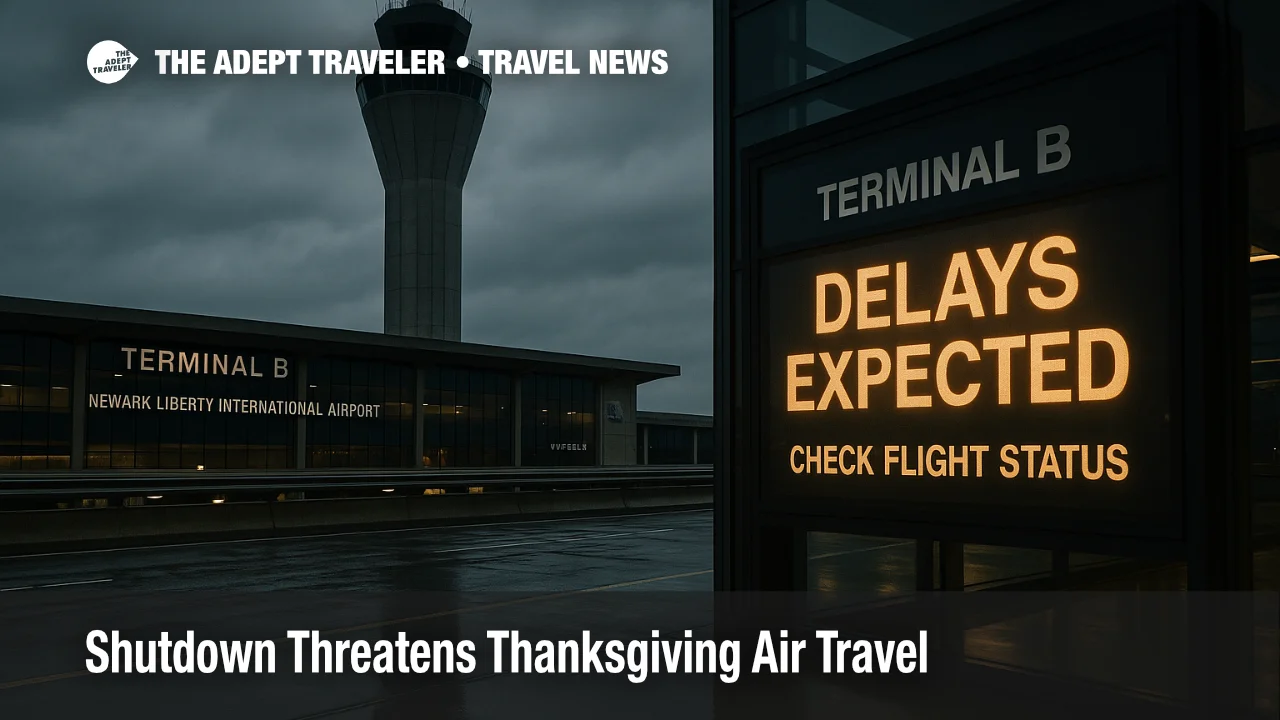Shutdown Threatens Thanksgiving Air Travel

Key points
- Air traffic controllers and TSA officers are working without pay amid the shutdown
- Delays climbed past 5,000 flights on Sunday, with Newark seeing repeated ground stops
- U.S. Travel Association warned Congress that Thanksgiving disruptions will worsen without a deal
Impact
- Expect Longer Lines
- Staffing shortages at security and in towers are slowing throughput
- Pad Connection Times
- Build extra time into tight connections at major hubs
- Monitor Waivers
- Airlines may issue change-fee waivers as delays and ground stops ripple
- Track Your Flight
- Use airline apps and FlightAware for gate and delay changes in real time
- Consider Alternates
- Rebook to earlier departures or nearby airports when possible
The U.S. government shutdown has entered its second month, and the strain is increasingly visible at airports. Air traffic controllers and Transportation Security Administration officers are working without pay, and flight delays are mounting ahead of the Thanksgiving peak. Industry groups are warning that the holiday rush could bring wider disruption unless Congress reopens the government. On Sunday, more than 5,000 flights to, from, or within the United States were delayed, a sign of the growing pressure on the system as facilities juggle staffing and weather constraints.
What changed for travelers
The shutdown, which began October 1, triggered furloughs across the Department of Transportation and left essential staff in safety-critical roles on duty without pay. Reuters reports the Federal Aviation Administration would furlough roughly 11,000 employees, while more than 13,000 controllers and about 50,000 TSA officers continue working without pay. That backdrop, combined with an existing controller shortfall at nearly half of major facilities, is contributing to nationwide delays and periodic ground stops at busy hubs like Newark Liberty International Airport.
Latest developments
The U.S. Travel Association, backed by a large coalition across the sector, urged congressional leaders to reopen the government before Thanksgiving, warning that while safety will be maintained, travelers will "pay a heavy and completely unnecessary price" in delays and cancellations. The association has estimated the shutdown's travel impact at about $1 billion per week.
At airports, Sunday's delay totals surpassed 5,000 flights, and Newark has faced repeated ground stops and lengthy arrival and departure programs as the FAA meters traffic to match staffing. Those constraints ripple to New York-area airports and onward connections across the country.
Analysis
For passengers, the practical effects arrive in three ways. First, security screening can slow as TSA reallocates people to the busiest checkpoints, which lengthens queues at peaks. Second, tower and center staffing shortages reduce the rate at which the FAA can safely land and launch aircraft, which extends "metering" programs and increases the risk of ground stops when demand and weather collide. Finally, rolling constraints at one hub propagate through airline networks, complicating connections and crew scheduling for the rest of the day.
Background, how this works: the FAA uses Traffic Management Initiatives such as Ground Delay Programs and Airspace Flow Programs to meter traffic into constrained airspace. When a facility is short on qualified controllers, the arrival rate may be cut, which forces airlines to delay or cancel flights to stay within safe limits. Unlike weather, which is episodic, staffing constraints can persist for an entire shift. With the shutdown, more facilities are operating close to their staffing floor, so routine weather or runway changes more easily tip the system into delays. Business Insider and Fortune both note that shortages at multiple facilities have compounded weather headwinds in recent days.
The policy fight centers on Affordable Care Act premium tax credits, which are set to lapse without legislative action. PBS and the Associated Press both report that the dispute over extending subsidies has stalled a broader funding deal, prolonging the shutdown as open enrollment begins. That political context matters to travelers only insofar as it shapes how long the system remains under stress. The longer the lapse continues, the more likely it is that absenteeism and fatigue further erode capacity even if overall safety is maintained.
For Thanksgiving week, the risk profile is clear. With historically high passenger volumes, even small reductions in throughput translate to outsized queuing and misconnects. U.S. Travel's latest warning underscores that the fastest way to reduce those risks is to reopen the government. Until then, the best defense is an early departure, generous buffers, and proactive rebooking when long ground delay programs appear at your origin or connection point.
Final thoughts
The shutdown's aviation impact is less about aircraft and more about people. Controllers and screeners are keeping the system safe, but thinner staffing leaves less margin for weather and peak traffic, a reality that will be felt most acutely during Thanksgiving week. Travelers who build in time, watch for waivers, and consider alternates will be best positioned to keep plans intact.
Sources
- U.S. Travel Association News & Commentary
- U.S. Travel Association: $1 Billion Lost Every Week
- U.S. Travel Association Letter to Congress (PDF)
- Reuters: US travel group warns Congress of Thanksgiving chaos
- Reuters: FAA would furlough 11,000 employees in shutdown
- Fortune: Nearly half of major ATC facilities short-staffed
- Business Insider: ATC shortages cause widespread delays
- Yahoo Finance live: FlightAware delays topped 5,000 over weekend
- AP: Health care debate central to shutdown
- PBS NewsHour: ACA subsidies at heart of funding fight
- People: Newark issues second ground stop amid staffing
